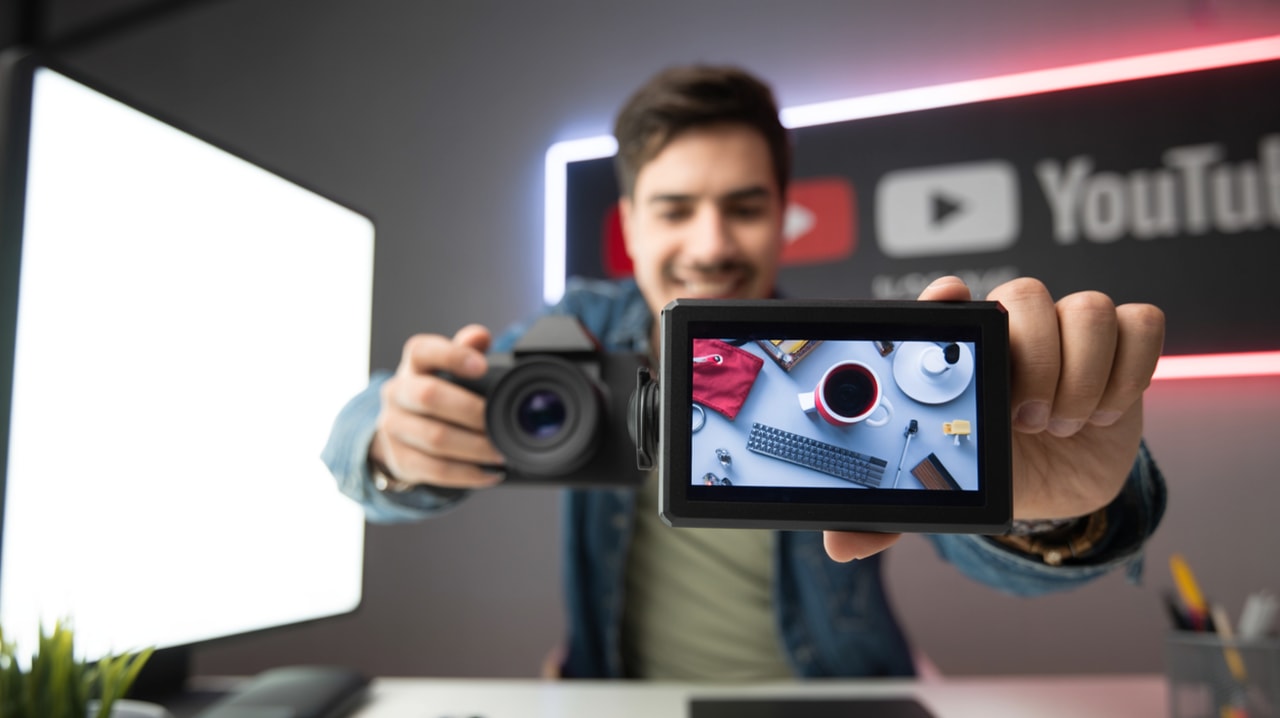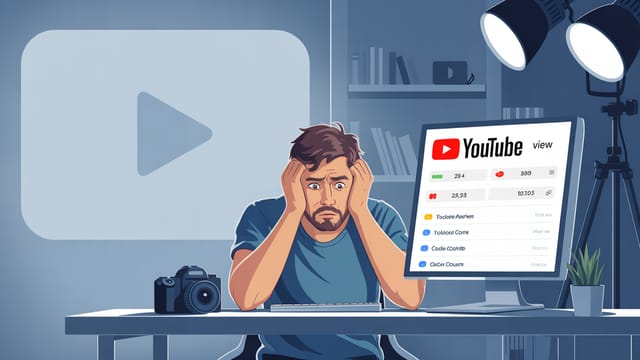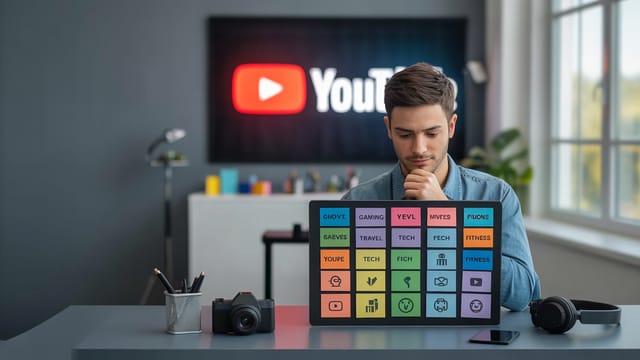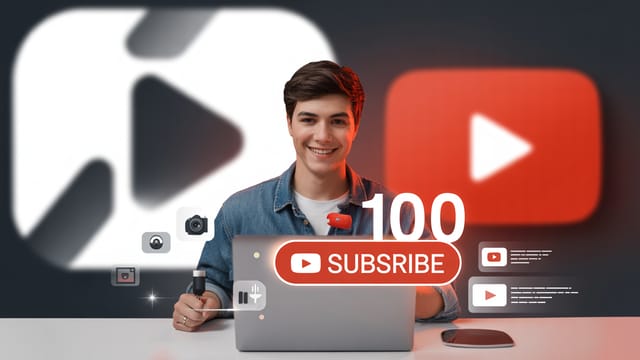
Ready to get your next 10,000 subscribers?
Join thousands of creators who use Subscribr to create faster, better YouTube videos.
Are your YouTube videos feeling a little… static? Do you find yourself staring at your main talking-head footage, wishing there was a way to make it more dynamic and visually interesting? You're not alone. Many intermediate creators struggle to elevate their video production quality beyond basic A-roll (your primary footage, usually you talking to the camera). This often leads to videos that, while informative, might not hold viewer attention as effectively as they could.
The solution lies in mastering the art of B-roll.
B-roll is supplementary footage that's cut together with your main A-roll. Think of it as visual storytelling that complements what you're saying. It's the shot of ingredients being chopped while you talk about a recipe, the footage of a product in use while you explain its features, or dynamic shots of a city while you narrate your travel experience. When done well, B-roll isn't just filler; it actively contributes to viewer engagement, enhances your narrative, and makes your videos look significantly more professional.
Channels like @LearnOnlineVideo, @StudioBinder, and @FullTimeFilmmaker, which focus on filmmaking and video production tips, consistently use high-quality B-roll to demonstrate concepts and keep viewers hooked. Mastering B-roll is a key step in improving your overall video quality and production value.
Why Engaging B-Roll is Your Secret Weapon on YouTube
In the competitive landscape of YouTube, keeping your audience engaged is paramount. The youtube_strategy tool highlights that using B-roll is "underrated" and can significantly enhance audience attention. Why? Because constantly looking at the same shot can become monotonous. B-roll provides visual variety, breaking up the A-roll and giving the viewer's eye something new and relevant to focus on.
Beyond just preventing boredom, effective B-roll:
- Adds Context and Detail: It shows, rather than just tells, providing visual proof or examples of what you're discussing.
- Enhances Emotional Connection: Cinematic B-roll, for example, can evoke feelings and set a mood that strengthens your story.
- Covers Edits and Transitions: Smoothly cutting to B-roll is a great way to hide jump cuts or transitions in your A-roll, making your video feel more polished.
- Boosts Perceived Production Value: Well-shot and edited B-roll makes your channel look more professional and established, even if you're still growing.
As the youtube_strategy insights suggest, incorporating B-roll should become a standard part of your production process, not an afterthought.
Strategic Planning for Impactful B-Roll
Simply grabbing random shots won't cut it. To create engaging B-roll, you need a plan. Instead of trying to match B-roll to your script point-by-point as you film your A-roll, a more efficient strategy is to first lock down your main A-roll, or at least have a solid outline or script. Then, review your content and identify specific points that would benefit from visual support. Create a list of the B-roll shots you need.
The youtube_strategy tool emphasizes the importance of shooting B-roll while you're already in "shoot mode." Your gear is set up, your lighting is ready, and you're in the right mindset. It's far easier to capture these supplementary clips then than to try and recreate the setup later.
Think about the story you want the B-roll to tell. What specific visuals will best illustrate your points or add atmosphere? Don't just film something; film the right something.
Must-Have B-Roll Shots for Every Creator
You don't need fancy equipment or a film crew to get great B-roll. Many impactful shots can be captured with just your main camera and a little creativity. Here are some easy B-roll shots you can start incorporating:
- Close-ups (CUs): Show details! Hands performing an action, a product feature, text on a page. Close-ups draw the viewer's attention to something specific.
- Medium Shots (MS) & Wide Shots (WS): Establish the environment or show the subject interacting with their surroundings. A medium shot might show you working at your desk, while a wide shot shows your entire workspace.
- Establishing Shots: Often wide shots that show the location or setting. This orients the viewer.
- Insert Shots: Similar to close-ups, these focus on a specific object or action relevant to the A-roll (e.g., pouring coffee while talking about your morning routine).
- Action Shots: Capture movement! Walking, typing, demonstrating a skill. This adds energy.
- Transition Shots: Shots that help you move smoothly from one scene or topic to another (e.g., walking out a door, turning a page).
Videos like @DanielSchiffer's "3 INCREDIBLY EASY B-ROLL HACKS" (607K views) or @SeanKitching's "7 CREATIVE Cinematic B ROLL Shot Ideas" (517K views) demonstrate how simple, well-composed shots can make a big difference. Pay attention to the examples they use – often focusing on everyday actions or objects shot in interesting ways.
Elevating Your B-Roll: Technical Tips
Achieving that professional look requires attention to technical details when shooting your B-roll. This directly addresses the pain point of difficulty in achieving consistent, professional-level video and audio quality.
- Camera Stability: Shaky B-roll is distracting. Use a tripod, monopod, or a gimbal for smooth, stable shots. Channels like @SeanKitching have popular videos like "The SECRET To SHOOTING GOOD B ROLL - A Behind The Scenes Demonstration" (220K views) demonstrating how to get stable shots, even when filming yourself.
- Lighting: Just like your A-roll, good lighting is crucial. Utilize natural light when possible, or use simple LED panels to properly expose your subject and create depth. Pay attention to the direction of light to add dimension and visual interest.
- Composition: Apply basic photography and filmmaking principles. Use the rule of thirds, leading lines, and create foreground, middle ground, and background to add depth to your shots. Think about framing and angles – shooting from a low or high angle can make a simple object look more dynamic.
- Focus: Ensure your subject is in focus. Using a shallower depth of field can help isolate your subject and create a more cinematic look.
- Frame Rate: Shoot your B-roll at a higher frame rate (like 60fps) even if your A-roll is 24fps or 30fps. This gives you the option to slow down the B-roll in editing for smooth, cinematic slow-motion sequences.
- Audio (Sometimes): While B-roll often doesn't require sync audio, capturing ambient sound or relevant sound effects during filming can greatly enhance the final edit.
Investing in affordable gear like a small tripod, a gimbal, or a simple lighting kit can significantly improve your B-roll quality. These tools directly support the technical skill development needed for better video production.
How Much B-Roll is Enough?
There's no magic number for how much B-roll you need. It depends entirely on the type of video you're making and your personal style. A fast-paced vlog might have B-roll covering 50-70% of the timeline, while a deep-dive tutorial might use it more sparingly, perhaps 20-30% of the time, mainly for demonstrations.
The key takeaway from expert advice (like that found via the youtube_strategy tool) is to shoot plenty of options. One creator mentioned that often around 90% of the B-roll footage they shoot doesn't end up in the final video, but having that large library ensures they have the perfect shot when they need it. Don't be afraid to over-shoot. Capture multiple angles, distances, and variations of the same action or object.
Over time, you can even build a general library of B-roll footage from your daily life, activities, or common locations you film in. This library becomes a valuable resource you can draw from for future videos, saving you time on dedicated B-roll shoots.
Seamlessly Integrating B-Roll in the Edit
This is where the magic happens and where you answer the question "How do I edit B-roll effectively into my main footage?". B-roll shouldn't feel like random clips; it should weave seamlessly with your A-roll to tell a cohesive story.
- Cut on Action: A classic editing technique where you cut from one shot to another during a movement. This makes the edit feel invisible and natural.
- Layer Above A-Roll: In your editing timeline, B-roll clips are typically placed on a video track above your A-roll. The viewer sees the B-roll, while the audio from your A-roll continues underneath.
- Use to Cover Cuts: If you make a mistake or need to remove a section from your A-roll, cutting to relevant B-roll is the perfect way to hide the jump cut and maintain flow.
- Vary Clip Lengths: Don't let B-roll clips linger too long unless it's intentional for pacing. Often, short, punchy B-roll shots are more impactful. Mix up the duration of your clips to keep the viewer engaged.
- Match the Tone: Ensure your B-roll's color grading, lighting, and overall feel match your A-roll and the mood of your video.
- Consider Sound Design: Add subtle sound effects or ambient noise to your B-roll clips to make them feel more immersive and grounded in reality.
Effective B-roll editing requires practice and developing an eye for visual rhythm and pacing. Watch videos from creators known for their editing style (many video production channels are great examples) and analyze how they use B-roll.
Tools to Enhance Your B-Roll Workflow
Improving your B-roll game involves both skill and efficient tools.
For planning and scripting your B-roll needs, platforms like Subscribr can be incredibly helpful. Within Subscribr's script building pipeline, you can use the outline and drafting phases to make notes about where B-roll is needed and what kind of shots you envision. You can even use the research features to gather visual inspiration or examples of B-roll techniques you want to try, assigning that research directly to sections of your script. This ensures your B-roll planning is integrated from the start.
When it comes to gear, consider tools that help you achieve smooth, dynamic shots:
- Gimbals: Electronic stabilizers that allow for incredibly smooth camera movements.
- Sliders: Devices that let you move your camera horizontally or vertically along a track, creating a smooth, gliding motion.
- Drones: For stunning aerial B-roll (ensure you follow all regulations!).
- Various Lenses: Different lenses (wide-angle, telephoto, macro) can give you distinct looks for your B-roll.
Including affiliate links to gimbals, sliders, or specific lenses that are great for B-roll is a natural way to monetize this type of content, providing value to your audience by recommending helpful tools. Additionally, promoting courses on visual storytelling or video production can provide a deeper dive for creators looking to master these techniques.
Conclusion
B-roll is far more than just filler; it's an essential tool for intermediate YouTubers looking to overcome static video syndrome and achieve a more professional, engaging, and dynamic feel. By strategically planning your shots, focusing on technical quality, shooting plenty of options, and thoughtfully integrating it in the edit, you can transform your videos. Start practicing these techniques today, build your B-roll library, and watch as your videos become more captivating and professional, keeping your audience hooked from start to finish. Your viewers (and the YouTube algorithm) will thank you.





